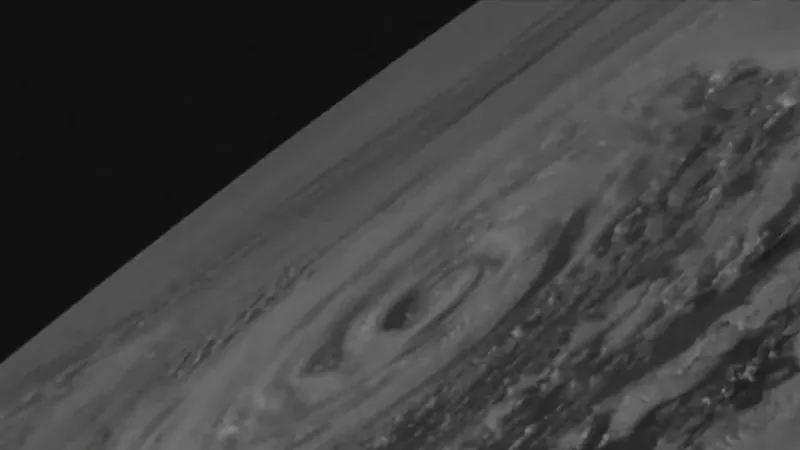A few times in science, a discovery surfaces that instantly changes the scale of our perspective. This new study from a remote Nevada cave does exactly that.
Researchers from Oregon State University recovered a calcite core holding 580,000 years of climate history, and the patterns buried in that stone feel eerily relevant to what the American Southwest is experiencing right now.
When I first read through the findings, what struck me most was how clearly the past mirrors our present.
The record shows repeating swings between cold, wet periods and blistering, water-starved heat, shifts so dramatic that entire ecosystems transformed. And those transformations often happened much faster than most people imagine.
A Hidden Climate Archive Beneath Nevada
Deep in the desert lies Devils Hole II, a cave barely accessible without technical diving gear. Unlike ice cores collected in Antarctica or Greenland, this desert cave sits in a region where climate archives almost never survive.
Harsh heat usually destroys natural records, but this particular system, a calcite deposit slowly forming underwater, preserved a rare, uninterrupted timeline of environmental change.
Scientists drilled out a one-meter calcite core, essentially a climate time capsule. According to lead researcher Kathleen Wendt, this slender piece of mineral holds half a million years of data:
“This meter-long core gives you a record of how the climate has changed over half a million years.”
The cave’s geology is so stable that each thin layer within the calcite precisely reflects the water conditions of its era, allowing researchers to reconstruct shifts in rainfall, groundwater levels, and vegetation far beyond what written or archaeological records can show.
Ice Ages, Warm Ages, and Dramatic Swings
The timeline that emerged from this core is anything but subtle. Nevada has repeatedly oscillated between two extremes:
- Glacial periods – cooler, wetter, and greener
- Interglacial periods – hot, dry, and severely water-limited
As Wendt explained:
“What we see over this time span are glacial periods, when Nevada was cooler and wetter, followed by interglacial periods, when Nevada was hot and dry, like what we’re experiencing today.”
During cooler eras, aquifers rose, vegetation expanded, and the region supported richer wildlife. But during warm interglacial periods, especially the midpoint of each one, groundwater levels plummeted, and plant life collapsed.
Reading through the study, I kept thinking about how precariously the modern Southwest depends on groundwater today. History shows that once water drops below a certain threshold, nature does not cushion the fall. Vegetation declines sharply, and recovery takes much longer than the decline.
A Shift in Storm Tracks That Rewrites the Map

One of the most fascinating pieces of this research is the evidence of shifting storm patterns. Today, moisture-rich Pacific storms mostly hit the Pacific Northwest.
But during past ice ages, that storm belt moved south, bringing significant rainfall into the Great Basin.
Co-author Christo Buizert summarized it:
“Today, the bulk of the rainstorms coming off the ocean hit the Pacific Northwest, but during ice age periods, that same belt of rainstorms would land a lot further south.”
This means Nevada’s water fortunes depended not only on local temperatures, but on the global positioning of atmospheric rivers and Pacific storm systems, something climate scientists are again watching closely as today’s warming atmosphere reshapes storm tracks across the Northern Hemisphere.
The study emphasizes that groundwater, rainfall, and temperature can’t be viewed separately. They interact in complex, often abrupt ways. In the past, when storm belts shifted north or south, entire regions flipped from wet to dry within geologically short periods.
Groundwater Collapse: The Point of No Return
The most alarming finding, and the one I personally find most difficult to ignore, involves the steep drop in groundwater levels during interglacial warm phases.
The study shows that once temperatures reached a certain threshold, groundwater availability fell rapidly, followed by severe vegetation decline.
Buizert noted:
“Midway through those interglacial periods, the available groundwater dropped sharply and vegetation plummeted.”
This pattern mirrors what’s already happening in parts of the Southwest today:
- declining aquifers
- record heat waves
- shrinking vegetation cover
- increased wildfire vulnerability
The cave record shows these are not isolated events; they’re part of a long historical pattern triggered by warming.
What Does This Mean for the Future of the Southwest?
The researchers avoid suggesting that modern conditions will unfold exactly as they did in the past. But the broad message is unmistakable: heat leads; water disappears; ecosystems struggle.
Buizert puts it plainly:
“This raises questions about what we might expect in this region in the future as the climate continues to change.”
The Southwest today is experiencing:
- some of the fastest-warming temperatures in the United States
- long-term megadrought conditions
- Aquifers are dropping faster than they can recharge
- rising water disputes between states and cities
The Nevada cave record doesn’t predict specific timelines, but it clearly shows that the Southwest is entering conditions that historically coincided with rapid ecological stress.
As someone who follows climate science closely, I find this discovery powerful because it doesn’t rely on computer models or projections.
It’s a physical record of what actually happened when the region warmed in the past. And in that record, the warning signs show up again and again.
A Window Into the Past, and a Mirror for the Present
An Oregon State professor and paleoclimatologist just published research on a calcite deposit in southern Nevada that reveals 580,000 years of climate record. https://t.co/ay1ihqGYwH
— KATU News (@KATUNews) November 20, 2025
This 580,000-year climate archive is more than a scientific curiosity. It’s a reminder that the Southwest has always been sensitive to temperature shifts, far more sensitive than many people assume. When the region warmed in the past, water disappeared quickly and ecosystems reorganized.
Today’s warming is happening faster than most of those ancient transitions.
And if the Nevada cave record tells us anything, it’s that once groundwater decline reaches a tipping point, the consequences become difficult to reverse.
In my view, this study doesn’t just deepen our understanding of paleoclimate. It sharpens the stakes of the present moment. It suggests that the window for protecting the Southwest’s water resources and the communities and ecosystems that depend on them may be narrower than we think.
The past may not repeat itself exactly, but this cave shows us the script that nature tends to follow.
Related Posts:
- Why the United States in 2050 Will Be Unrecognizable…
- US Prepares for Climate Migration with "Receiving…
- Top 4 Seasons With Record Denver Nuggets Attendance
- How America Spends, Shops, and Travels on July 4th -…
- 30 Million People Struggle to Breathe - Delhi’s Smog…
- The Silent Crisis - Statistical Trends in Jockey…







